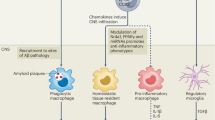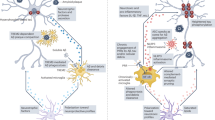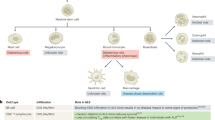Abstract
Treatment of Alzheimer disease or amyotrophic lateral sclerosis with anti-inflammatory drugs (to prevent disease or slow its progression) has yielded mixed results, despite evidence indicating that local cytotoxic inflammation occurs in these conditions. Here, through consideration of the importance of immune cell origin (resident versus blood-derived immune cells) and activity (pro-inflammatory versus anti-inflammatory activity) under neurodegenerative conditions, we propose a model that reconciles these seemingly inconsistent data. We suggest that systemic immune cells (CD4+ T cells and peripheral blood-derived monocytes) must be recruited to the CNS to modify potentially destructive local inflammation, and that the failure of systemic anti-inflammatory drug therapies to arrest neurodegenerative disease progression might result from drug-induced suppression of such recruitment. Thus, we propose that an appreciation of the distinctive temporal and spatial contributions of resident and systemic leukocytes to disease progression is essential for the development of effective therapeutic regimens.
This is a preview of subscription content, access via your institution
Access options
Subscribe to this journal
Receive 12 print issues and online access
$209.00 per year
only $17.42 per issue
Buy this article
- Purchase on SpringerLink
- Instant access to full article PDF
Prices may be subject to local taxes which are calculated during checkout


Similar content being viewed by others
References
Hardy, J. & Selkoe, D. J. The amyloid hypothesis of Alzheimer's disease: progress and problems on the road to therapeutics. Science 297, 353–356 (2002).
Pasinelli, P. & Brown, R. H. Molecular biology of amyotrophic lateral sclerosis: insights from genetics. Nat. Rev. Neurosci. 7, 710–723 (2006).
McGeer, P. L., McGeer, E., Rogers, J. & Sibley, J. Anti-inflammatory drugs and Alzheimer disease. Lancet 335, 1037 (1990).
McGeer, P. L. & McGeer, E. G. Polymorphisms in inflammatory genes and the risk of Alzheimer disease. Arch. Neurol. 58, 1790–1792 (2001).
Boster, A. et al. Intense immunosuppression in patients with rapidly worsening multiple sclerosis: treatment guidelines for the clinician. Lancet Neurol. 7, 173–183 (2008).
Zhu, S. et al. Minocycline inhibits cytochrome c release and delays progression of amyotrophic lateral sclerosis in mice. Nature 417, 74–78 (2002).
Cudkowicz, M. E. et al. Trial of celecoxib in amyotrophic lateral sclerosis. Ann. Neurol. 60, 22–31 (2006).
Gordon, P. H. et al. Efficacy of minocycline in patients with amyotrophic lateral sclerosis: a phase III randomised trial. Lancet Neurol. 6, 1045–1053 (2007).
Breitner, J. C. et al. Risk of dementia and AD with prior exposure to NSAIDs in an elderly community-based cohort. Neurology 72, 1899–1905 (2009).
Popovich, P. G. & Longbrake, E. E. Can the immune system be harnessed to repair the CNS? Nat. Rev. Neurosci. 9, 481–493 (2008).
Hanisch, U. K. & Kettenmann, H. Microglia: active sensor and versatile effector cells in the normal and pathologic brain. Nat. Neurosci. 10, 1387–1394 (2007).
Wyss-Coray, T. Inflammation in Alzheimer disease: driving force, bystander or beneficial response? Nat. Med. 12, 1005–1015 (2006).
Meda, L. et al. Activation of microglial cells by β-amyloid protein and interferon-γ. Nature 374, 647–650 (1995).
Takeuchi, A. et al. Microglial NO induces delayed neuronal death following acute injury in the striatum. Eur. J. Neurosci. 10, 1613–1620 (1998).
Davoust, N., Vuaillat, C., Androdias, G. & Nataf, S. From bone marrow to microglia: barriers and avenues. Trends Immunol. 29, 227–234 (2008).
Lucin, K. M. & Wyss-Coray, T. Immune activation in brain aging and neurodegeneration: too much or too little? Neuron 64, 110–122 (2009).
Yong, V. W. & Rivest, S. Taking advantage of the systemic immune system to cure brain diseases. Neuron 64, 55–60 (2009).
Wyss-Coray, T. & Mucke, L. Inflammation in neurodegenerative disease—a double-edged sword. Neuron 35, 419–432 (2002).
Shechter, R. et al. Infiltrating blood-derived macrophages are vital cells playing an anti-inflammatory role in recovery from spinal cord injury in mice. PLoS Med. 6, e1000113 (2009).
Butovsky, O., Kunis, G., Koronyo-Hamaoui, M. & Schwartz, M. Selective ablation of bone marrow-derived dendritic cells increases amyloid plaques in a mouse Alzheimer's disease model. Eur. J. Neurosci. 26, 413–416 (2007).
Simard, A. R. & Rivest, S. Bone marrow stem cells have the ability to populate the entire central nervous system into fully differentiated parenchymal microglia. FASEB J. 18, 998–1000 (2004).
Town, T. et al. Blocking TGF-β-Smad2/3 innate immune signaling mitigates Alzheimer-like pathology. Nat. Med. 14, 681–687 (2008).
Koronyo-Hamaoui, M. et al. Attenuation of AD-like neuropathology by harnessing peripheral immune cells: local elevation of IL-10 and MMP-9. J. Neurochem. 111, 1409–1424 (2009).
Butovsky, O. et al. Glatiramer acetate fights against Alzheimer's disease by inducing dendritic-like microglia expressing insulin-like growth factor 1. Proc. Natl Acad. Sci. USA 103, 11784–11789 (2006).
Kang, J. & Rivest, S. MyD88-deficient bone marrow cells accelerate onset and reduce survival in a mouse model of amyotrophic lateral sclerosis. J. Cell Biol. 179, 1219–1230 (2007).
Moalem, G. et al. Autoimmune T cells protect neurons from secondary degeneration after central nervous system axotomy. Nat. Med. 5, 49–55 (1999).
Schwartz, M., Shaked, I., Fisher, J., Mizrahi, T. & Schori, H. Protective autoimmunity against the enemy within: fighting glutamate toxicity. Trends Neurosci. 26, 297–302 (2003).
Butovsky, O. et al. Glatiramer acetate fights against Alzheimer's disease by inducing dendritic-like microglia expressing insulin-like growth factor 1. Proc. Natl Acad. Sci. USA 103, 11784–11789 (2006).
Kipnis, J., Avidan, H., Caspi, R. R. & Schwartz, M. Dual effect of CD4+CD25+ regulatory T cells in neurodegeneration: a dialogue with microglia. Proc. Natl Acad. Sci. USA 101 (Suppl. 2), 14663–14669 (2004).
Beers, D. R., Henkel, J. S., Zhao, W., Wang, J. & Appel, S. H. CD4+ T cells support glial neuroprotection, slow disease progression, and modify glial morphology in an animal model of inherited ALS. Proc. Natl Acad. Sci. USA 105, 15558–15563 (2008).
Chiu, I. M. et al. T lymphocytes potentiate endogenous neuroprotective inflammation in a mouse model of ALS. Proc. Natl Acad. Sci. USA 105, 17913–17918 (2008).
Banerjee, R. et al. Adaptive immune neuroprotection in G93A-SOD1 amyotrophic lateral sclerosis mice. PLoS ONE 3, e2740 (2008).
Frenkel, D., Maron, R., Burt, D. S. & Weiner, H. L. Nasal vaccination with a proteosome-based adjuvant and glatiramer acetate clears β-amyloid in a mouse model of Alzheimer disease. J. Clin. Invest. 115, 2423–2433 (2005).
Ziv, Y. et al. Immune cells contribute to the maintenance of neurogenesis and spatial learning abilities in adulthood. Nat. Neurosci. 9, 268–275 (2006).
Wolf, S. A. et al. CD4-positive T lymphocytes provide a neuroimmunological link in the control of adult hippocampal neurogenesis. J. Immunol. 182, 3979–3984 (2009).
Kipnis, J., Cohen, H., Cardon, M., Ziv, Y. & Schwartz, M. T cell deficiency leads to cognitive dysfunction: implications for therapeutic vaccination for schizophrenia and other psychiatric conditions. Proc. Natl Acad. Sci. USA 101, 8180–8185 (2004).
Kipnis, J., Derecki, N. C., Yang, C. & Scrable, H. Immunity and cognition: what do age-related dementia, HIV-dementia and 'chemo-brain' have in common? Trends Immunol. 29, 455–463 (2008).
Lewitus, G. M. et al. Vaccination as a novel approach for treating depressive behavior. Biol. Psychiatry 65, 283–288 (2009).
Ron-Harel, N. & Schwartz, M. Immune senescence and brain aging: can rejuvenation of immunity reverse memory loss? Trends Neurosci. 32, 367–375 (2009).
Ray, S. et al. Classification and prediction of clinical Alzheimer's diagnosis based on plasma signaling proteins. Nat. Med. 13, 1359–1362 (2007).
Fiala, M. et al. Ineffective phagocytosis of amyloid-β by macrophages of Alzheimer's disease patients. J. Alzheimers Dis. 7, 221–232 (2005).
Richartz-Salzburger, E. et al. Altered lymphocyte distribution in Alzheimer's disease. J. Psychiatr. Res. 41, 174–178 (2007).
Irizarry, M. C. Biomarkers of Alzheimer disease in plasma. NeuroRx 1, 226–234 (2004).
Seksenyan, A. et al. Thymic involution in amyotrophic lateral sclerosis. J. Cell. Mol. Med. doi: 10.1111/j.1582–49342009.00863.x.
Ransohoff, R. M., Kivisäkk, P. & Kidd, G. Three or more routes for leukocyte migration into the central nervous system. Nat. Rev. Immunol. 3, 569–581 (2003).
Schwartz, M. & Shechter, R. Protective autoimmunity functions by intracranial immunosurveillance to support the mind: the missing link between health and disease. Mol. Psychiatry 15, 342–354 (2010).
Acknowledgements
M. Schwartz is in part supported by a European Research Council (http://erc.europa.eu) research grant award and by an Israel Science Foundation-Legacy grant. We thank Shelley Schwarzbaum (The Weizmann Institute of Science) for editing the manuscript and Dr Liora Cahalon (Department of Neurobiology, The Weizmann Institute of Science) for assisting in the compilation of Supplementary Table 1.
Author information
Authors and Affiliations
Corresponding author
Ethics declarations
Competing interests
The authors declare no competing financial interests.
Supplementary information
Supplementary Table 1
Summary of the main anti-inflammatory clinical trials in Alzheimer disease and amyotrophic lateral sclerosis (DOC 126 kb)
Rights and permissions
About this article
Cite this article
Schwartz, M., Shechter, R. Systemic inflammatory cells fight off neurodegenerative disease. Nat Rev Neurol 6, 405–410 (2010). https://doi.org/10.1038/nrneurol.2010.71
Published:
Issue Date:
DOI: https://doi.org/10.1038/nrneurol.2010.71
This article is cited by
-
Intracerebral haemorrhage
Nature Reviews Disease Primers (2023)
-
Association of Telomere Length with Cognitive Impairment
Journal of Molecular Neuroscience (2023)
-
A story of the potential effect of non-steroidal anti-inflammatory drugs (NSAIDs) in Parkinson’s disease: beneficial or detrimental effects
Inflammopharmacology (2023)
-
Why do anti-inflammatory signals of bone marrow-derived stromal cells improve neurodegenerative conditions where anti-inflammatory drugs fail?
Journal of Neural Transmission (2020)
-
Observational and genetic studies of short telomeres and Alzheimer’s disease in 67,000 and 152,000 individuals: a Mendelian randomization study
European Journal of Epidemiology (2020)



